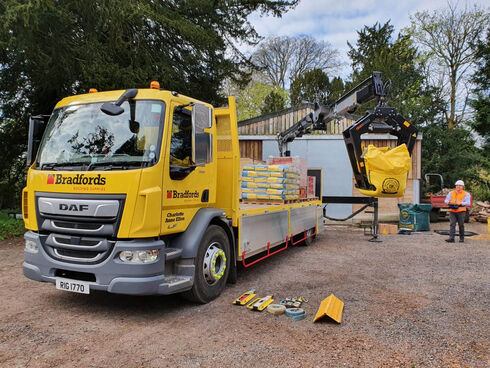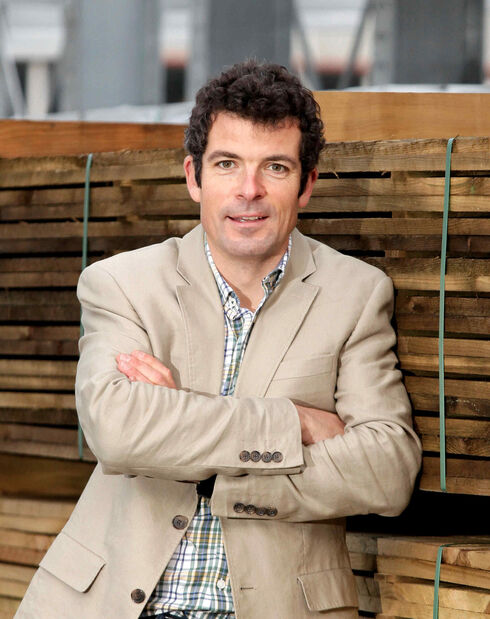
“Sustainability means success”
2 September 2021

Giles Bradford is from the seventh generation of the family that is behind what is now Bradfords Building Supplies, the Yeovil-based builders’ merchant and tool hire company.
Amongst other responsibilities, he is Head of Sustainability for the company. He is also Chair of the Builders’ Merchants Federation’s Sustainability Forum and sits on the Construction Leadership Council’s Green Construction Board.
Sustainability is something Giles (pictured below) feels a particular responsibility for, given Bradfords’ long pedigree and his current tenure as the surnamed Bradford in the business.
“Sustainability means enduring success. We have 250 years of that behind us and so it’s not surprising that it’s something I get very passionate about,” Giles told me.
“However, you have to be honest about what sustainability implies right now and recognise that we are all just at the start of the journey to net zero. It would be lovely to say that we will all adopt electric delivery trucks, offer only ‘eco’ products, install air source heat pumps in all our branches and so on, but it’s not that simple.
“Some things aren’t viable or practical yet. And it’s a bold company that can turn round to its customers and say ‘we know what you want even if you don’t’ when we are all still learning. No-one wants to offer something that turns out to be another Betamax [the format that lost out to VHS when video recorders became popular in the 1970s].
“You can switch from diesel to electric or hybrid cars, but there needs to be sufficient charging points available. And the vehicles are expensive. So what sounds easy conceptually can be difficult in practice.”
Giles also stresses one of the most important factors in the sustainability issue: the need to assess the entire carbon footprint of a product or service, from design to disposal.
He points out that some materials or products might be made of greener materials but if they are produced and then shipped thousands of miles away, deplete scarce mineral resources or are reliant on low-paid labour, it defeats the object.
It’s the same for a sustainable product that lasts only a fraction of the time that a ‘traditional’ material does before needing replaced.
“Concrete, say, might be regarded as the ‘Voldemort’ of building materials because of the carbon associated with the material it’s made of and the carbon emissions associated with producing it,” said Giles. “But if I obtain it from a quarry five miles away and it lasts several lifetimes, and if it’s used intelligently as a heat sink, it may have a lower lifetime carbon footprint than installing a heat pump, solar panels and better insulation in a building.
“Cost might also mean a more sustainable product has a very long payback time – solar panels on domestic roofs, for example. Upfront capital requirement presents an immediate barrier whilst many are not prepared to think as long term as the payback might be. Unsurprisingly, people don’t want to pay for solar on their roof, only for the next owner to be the one who really benefits.
“There are of course certain things that can be done more immediately and in our own estate, such as installing flow restrictors on taps to conserve water, choosing electricity suppliers that use renewable sources, using battery powered forklifts and reducing landfill waste.”
Giles also highlights another issue mentioned previously on the blog concerning Scope 1, 2 and 3 carbon emissions. Briefly, the first two are directly and indirectly within an organisation’s control, while Scope 3 relates to its entire supply chain.
“Scope 3 is the real challenge. It’s about how we influence others in the supply chain to change the way they do things, from manufacturing and packaging, to energy consumption and transport,” he said. “This is where industry collaboration becomes so important. Together we have a louder voice.”
Another challenge is persuading construction customers to adopt new working practices and products, especially when some of the technology is difficult to grasp conceptually.
Giles cites the statistic that 60% of the embodied carbon in a typical house comes from the materials its is made of. And 30% arises during the building’s lifetime, such as heating or water consumption.
“10% is due to the actual construction of the building, which is where merchants and hirers have an involvement. We need to help the trades people and other users on their journey to net zero. And we need to get it right from both an environmental and a commercial perspective.
“Above all, there are around 28 million homes already in the UK, many of which may require retro-fit equipment and services to increase sustainability, from hydrogen fuelled boilers to solar panels. The scope is huge.
“Indeed, to reach that number, every one of our 44 Bradfords merchant branches would need to support the whole house retro-fit of two houses per working day between now and 2040. The scale is huge and so the industry needs to work out how we supply and resource that challenge.”
• The CLC recently published a strategy to reduce carbon in the industry and to ultimately achieve net zero.
For more latest stories click here.


